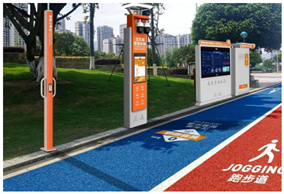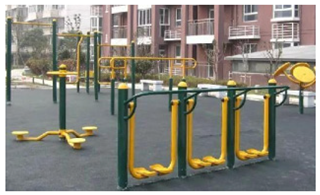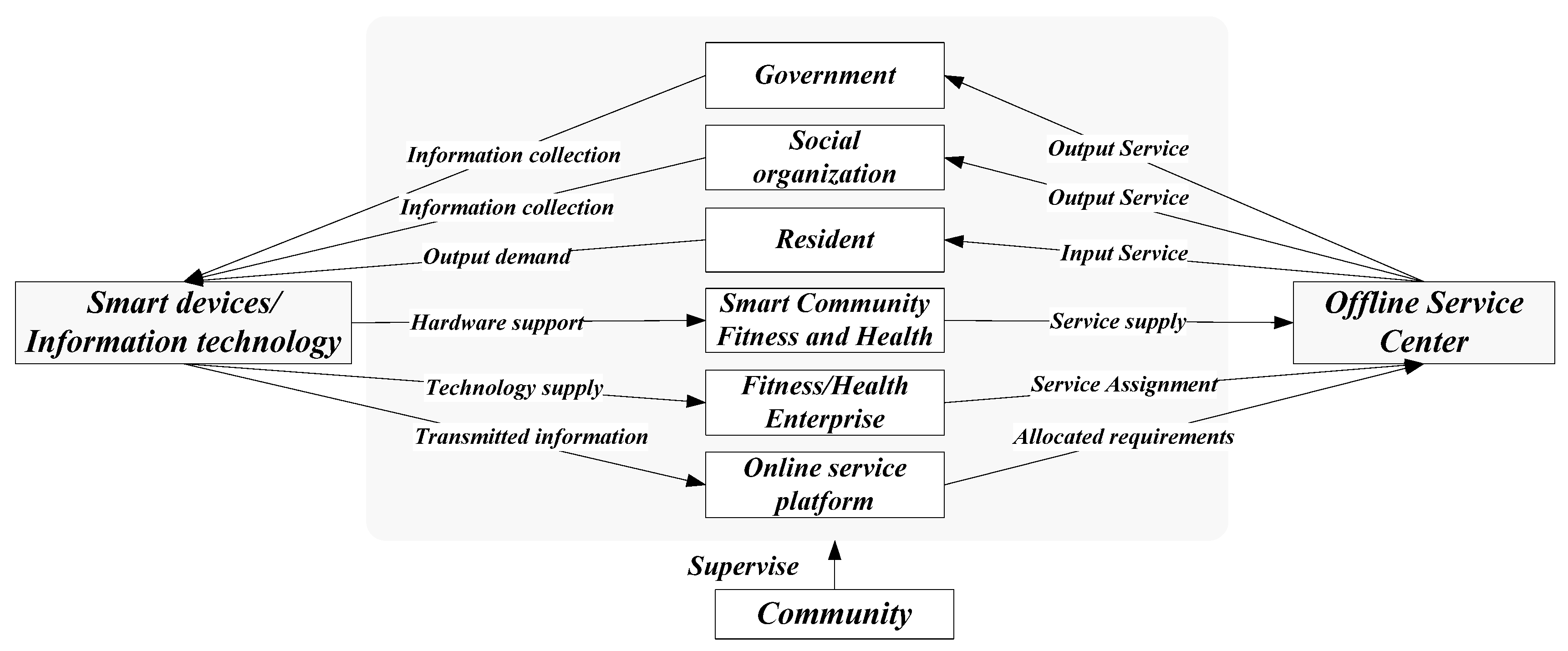1. Introduction
Amid the global push for sustainable urban development outlined by the Sustainable Development Goals (SDGs), integrating fitness and health has become essential for fostering well-being [
1]. Globally, countries are adopting policies to promote active lifestyles and health synergies, with initiatives such as the World Health Organization’s Global Action Plan on Physical Activity 2018–2030 encouraging cross-sector collaboration to address lifestyle-related diseases [
2,
3]. Smart communities rely on IoT and big data technologies to rebuild their service ecosystems. For example, they use smart devices and software platforms to build information platforms that share information, integrate services, and optimize resources, ultimately achieving intelligent management and innovative services within the community [
4]. However, as smart communities mature, challenges persist in realizing effective fitness-health integration through digital platforms [
5]. Current smart systems often overlook specialized support for fitness and health services [
6,
7]. Additionally, cross-sectoral governance remains inefficient, with misaligned resource allocation and fragmented service delivery, limiting the potential of smart technologies to enhance urban health [
8,
9]. These gaps highlight the need for a more coordinated governance framework that leverages multiactor collaboration to bridge service and resource divides.
Existing literature frequently conceptualizes fitness-health integration as a mere intersection of two sectors, overlooking both the transformative potential of modern technologies and the complexities inherent in community structures and multiactor governance [
10,
11]. Smart communities, leveraging information technologies, present an innovative governance paradigm by centralizing diverse services within unified smart management systems [
12]. Such systems provide critical infrastructure to operationalize fitness-health integration in daily life. Specifically, smart platforms facilitate not only the convergence of fitness and health services but also real-time data dissemination to residents, thereby improving managerial efficiency and resource allocation [
13]. For example, using data from mobile fitness apps to understand when and where residents exercise provides an excellent opportunity to identify the fundamental factors that influence urban residents’ exercise activities [
14]. Despite these advancements, implementation gaps persist. Current systems lack robust interaction mechanisms between fitness and health services, while the dearth of specialized integration platforms hinders meaningful synergy [
15]. These limitations underscore the necessity to reconceptualize fitness-health collaboration—transcending technological instrumentation to align governance frameworks with the operational realities of smart communities [
16,
17].
Globally, multiactor collaborative governance has emerged as a predominant community management model [
18]. Its efficacy hinges on government leadership, clear role delineation, and active engagement of social organizations and citizens to foster co-construction, co-governance, and shared outcomes [
19]. Among these, the government is responsible for policy formulation and monitoring community dynamics [
20]; businesses provide technical equipment and manage service supply chains [
21]; social organizations bridge policy implementation gaps by designing effective public service projects, helping communities become more intelligent [
22]; and residents promote the sustainable development of smart communities through active participation in their construction [
23]. Multistakeholder collaboration ensures resource liquidity and a closed-loop responsibility system. Yet, within smart communities, divergent priorities among governmental, societal, market, and resident stakeholders often impede coordinated governance [
24]. Compounding this issue, an overreliance on rudimentary technical tools diminishes governance efficacy, ultimately constraining communities’ ability to advance fitness-health integration.
Existing studies on fitness-health integration have focused primarily on its significance, pathways, and mechanisms, yet few address how such integration can be realized within smart communities [
25]. This gap leaves unanswered the critical question of how to operationalize fitness-health synergies under digital governance frameworks. As modern governance increasingly demands both collaborative management and technological modernization, there is an urgent need to explore practical solutions [
26]. As an important vehicle for technology-enabled governance, smart communities significantly improve the efficiency and accuracy of public service responses through digital platforms such as one-stop services and online feedback mechanisms, thereby enhancing resident satisfaction [
1,
2,
5]. At the same time, intelligent facilities such as remote health monitoring and online activity reservations shorten the physical and cognitive distance between residents and services, effectively reducing the “psychological distance” between them and the governing entities [
3,
6,
10], laying the foundation for building trust and a sense of participation. Consequently, based on the collaborative governance theory, in this study, we compare smart urban communities in Xiamen, China, with traditional urban villages, investigating governance models that promote fitness-health integration. We measure the outcomes of multiactor collaboration, analyze residents’ perceived psychological distance from and satisfaction with governance, and provide insights into how collaborative frameworks can effectively advance fitness-health integration within smart communities.
The findings of our study help to restructure the collaborative governance framework for fitness-health integration in smart communities, offering a foundation for enhancing participatory decision-making among multiple stakeholders. At the theoretical level, the findings elucidate how smart fitness facilities and health services influence residents’ satisfaction and psychological distance, expanding the application of the technology acceptance model (TAM) and the Theory of Perceived Scenario in community governance. At the practical level, through scenario-based experiments, this study helps develop an ecological public service model for integrated fitness-health governance, expanding the theoretical scope of community management. Herein, we propose and evaluate a multiactor governance model that drives the deeper integration of fitness and health in smart communities. The model leverages big data, the internet, and cloud computing to streamline service delivery and product demand, fostering efficient resource integration and seamless information sharing. This approach offers valuable insights for advancing “sports+” initiatives, providing a practical reference for promoting fitness-health synergies in the digital era.
7. Conclusions, Discussion, and Implications
7.1. Conclusions and Discussion
First, our study reveals significant differences in residents’ satisfaction levels with fitness and health public services between smart and non-smart community models (
H1). Residents in smart communities report higher satisfaction levels than those in non-smart communities. This conclusion supports the view put forward by Zavratnik et al. that technology can enhance the value of public services [
12], while also deepening Granier’s research on citizen participation mechanisms. Spatial analysis reveals the optimization path of smart technology for grassroots health services [
30]. This finding underscores the notion that technology is a key differentiator, enabling smart communities to leverage information technology in management and service delivery. By breaking down temporal and spatial barriers, these technologies foster interactive and personalized information exchanges, effectively advancing governance practices.
Second, this study reveals significant differences between smart community models and non-smart community models in terms of residents’ psychological distance from the community (
H2). Specifically, residents of smart communities participate more directly in community affairs through digital public services and interactive platforms, such as fitness and health monitoring systems, thereby enhancing their sense of belonging [
56]. Meanwhile, smart governance models optimize the layout of public spaces and the efficiency of facility responses, thereby reducing the physical and psychological barriers between residents and community resources, significantly narrowing the psychological distance [
50,
58]. This conclusion aligns with Trope and Liberman’s psychological distance theory, which emphasizes that technological interventions can influence individual cognition by regulating spatial, temporal, and social dimensions [
66]. It also expands on Zavratnik et al.‘s research on “community-centric” smart development, moving from technological application to empirical validation of residents’ psychological perceptions [
12].
Third, the impact of smart communities on resident satisfaction is mediated by psychological distance (
H3). In smart community settings, residents perceive a closer psychological proximity to participation in fitness and health activities. Consequently, their level of satisfaction with community public services increases. Previous research has focused predominantly on the psychological distance of residents in online virtual communities, leaving a gap in understanding the psychological distance experienced by residents in real communities, particularly within smart communities [
82]. This study bridges that gap by demonstrating the mediating role of psychological distance between the level of community smartness and residents’ satisfaction in two real community contexts, namely, smart communities and urban villages.
Finally, the relationship between psychological distance and residents’ satisfaction with public services is moderated by the community governance model (
H4). Compared with a single-actor governance model, the multiactor collaborative governance approach strengthens the positive impact of psychological distance on residents’ satisfaction. These findings reinforce the perspective that diverse and collaborative governance enhances community management effectiveness, aligning with established views on community governance [
83].
In summary, this study confirmed the positive impact of the smart community model on resident satisfaction and psychological distance through a scenario experiment and two field surveys, while also verifying the moderating role of collaborative governance in the relationship between psychological distance and satisfaction. Specifically, smart communities leverage their technological advantages to precisely match residents’ needs, directly enhancing their satisfaction. Additionally, they can reduce residents’ psychological distance through the design of emotional engagement programs, thereby indirectly improving their satisfaction. In this context, multistakeholder collaborative governance amplifies the impact of psychological distance on residents’ satisfaction.
7.2. Theoretical Contributions
The findings of this research help to advance the understanding of collaborative governance theory by establishing a model for integrating fitness and health services in smart communities. This model highlights the necessity of smart technologies and diverse stakeholder participation in the convergence of community fitness and health, elucidating the distinct roles played by various stakeholders in meeting residents’ needs.
First, it advances the understanding of technology-driven governance by quantitatively validating the link between smart community development and residents’ satisfaction with public services. While prior research emphasizes the infrastructural benefits of smart communities [
84], this study empirically demonstrates that technology-enhanced governance significantly improves satisfaction with health services compared to traditional communities. This finding extends the technology acceptance model (TAM) in a community governance context, suggesting that smart platforms not only facilitate service integration but also enhance perceived service quality, thereby bridging the gap between fitness and health initiatives [
85].
Second, the study introduces psychological distance as a novel mediator between smart community development and resident satisfaction. Whereas existing literature predominantly examines objective measures of community performance [
14], this research reveals that residents’ subjective perceptions of accessibility, trust, and engagement critically shape their satisfaction levels. This aligns with construal level theory [
66], positing that reduced psychological distance, through transparent governance and responsive technology, fosters stronger resident-community connections. By identifying this mechanism, the study shifts the discourse from purely structural factors to resident-centric governance models [
86,
87,
88].
Third, the research refines collaborative governance theory by contrasting single-actor and multiactor approaches. Previous work highlights the conceptual benefits of multiactor collaboration; however, this study provides empirical evidence that such governance moderates the psychological distance-satisfaction relationship. Specifically, it shows that when governments, social organizations, and residents co-manage services, psychological barriers diminish, leading to higher satisfaction. This finding challenges the techno-determinism prevalent in smart city literature, underscoring that effective governance requires both technological infrastructure and institutional cooperation.
7.3. Practical Implications
First, leveraging information technology to enhance residents’ health is essential. Establishing a data platform for community fitness and health can facilitate efficient data flow, addressing the barriers posed by ineffective communication. Increasing the prevalence of smart technologies in urban communities, including the development of more smart gyms and the introduction of advanced health monitoring devices, can significantly improve the quality of fitness and health services provided to residents. Moreover, creating effective connections between hospitals and communities, allowing healthcare providers to issue fitness prescriptions on the basis of residents’ uploaded data, can further enhance health outcomes.
Second, minimizing the psychological distance in accessing fitness and health services is crucial. By utilizing residential data, communities should ensure that public services are within a 15-minute reach for all residents. Underpinning this approach with Internet of Things (IoT) technology will enable the centralization of detailed information on fitness and health services, thereby making such information accessible through community information platforms. Additionally, establishing online fitness platforms can encourage residents to log their activities and share suggestions for service improvements, thus fostering community engagement.
Third, developing a collaborative governance model that involves multiple stakeholders is vital [
89,
90,
91]. Engaging market players and nurturing social organizations can help streamline the establishment of fitness initiatives and the organization of community sporting events. Providing policy support, such as tax reductions and financial incentives for enterprises, will empower businesses to contribute effectively to community health and fitness offerings. Furthermore, enhancing talent development mechanisms in educational institutions to better align with the needs of the health and fitness sectors will continuously drive innovation within smart communities. By establishing a comprehensive industry chain that connects communities, governments, residents, and businesses, the integration of fitness and health services can be advanced, thereby enriching the available products and services for residents.
7.4. Limitations and Future Research
In this study, which is grounded in collaborative governance theory, we explore the impact of a smart community’s integration of fitness and health services on residents’ satisfaction levels and assess the effectiveness of the multiactor governance model. The main limitations are as follows: firstly, the study mainly used a sample of Xiamen community residents for the online experiment, which may cause problems in terms of generalizability, and this should be further verified in future studies by using samples from different urban communities. Second, the study did not further disaggregate public services and health services, and thus could not compare residents’ satisfaction with different types of services with perceived psychological distance. Future research could delve deeper into satisfaction levels across different types of public fitness and health services. Additionally, while psychological distance serves as a key mediator, further qualitative investigations could provide insights into the psychological factors influencing residents’ satisfaction, thereby enriching the understanding of this dynamic. Finally, in terms of methodology, this study does not provide an in-depth analysis of the dynamic process of multistakeholder collaborative governance. In the future, multi-source data can be integrated for detailed analysis.


















